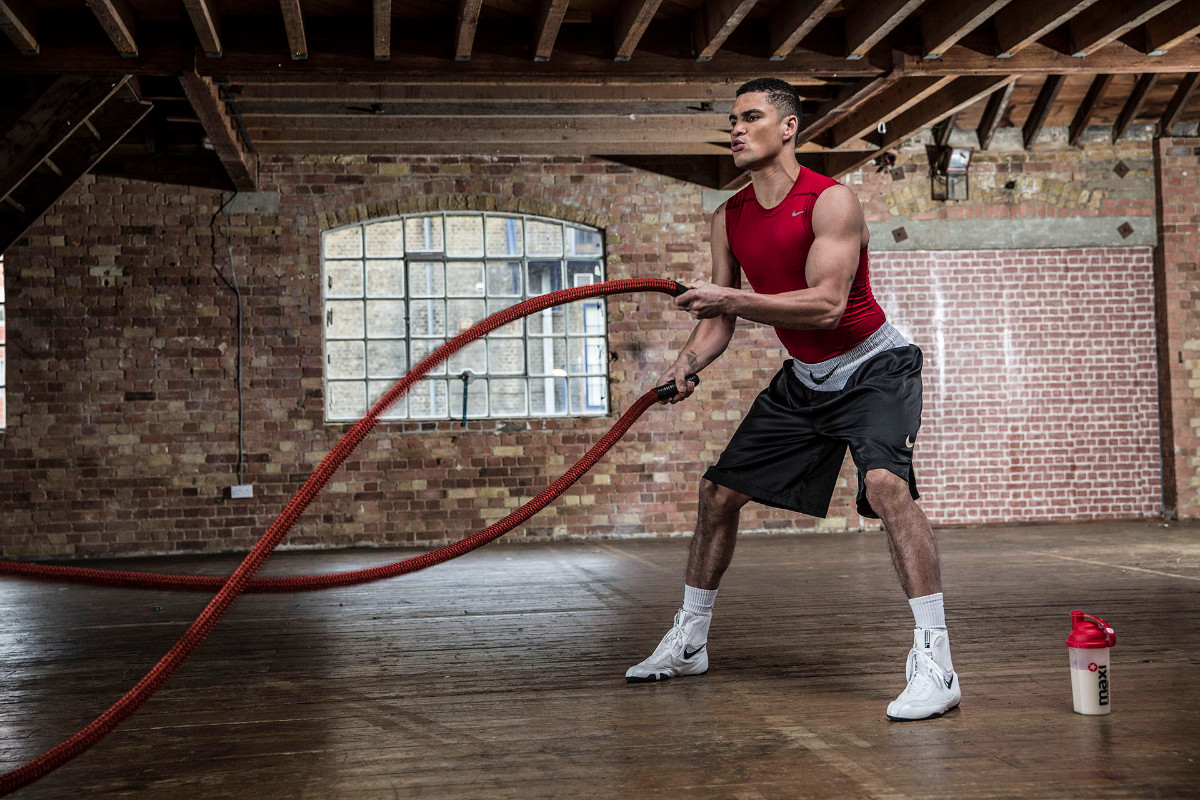Footwork
I’ve taken inspiration from boxing greats and like to utilise various elements from other sports and disciplines to give me the edge when fighting.
1) Ladder drills
* Front and side controlled
o Side onto the ladder, step forward into a box with lead foot, then back out, move to the side and then forward into the next box. Repeat.
* Front and side fast
o Same as above but instead of slow and steady, performed on the toes bobbing and weaving.
* Boxing step through
o Adopt a boxing stance slightly to one side with front foot in a square. Step to the front and side to allow front foot to come out of box and rear foot to come in. Step front foot to front and side again and back foot comes out of box (both feet out), step front foot to front and opposite side and back foot goes into box. Step front foot front and side again and back foot comes out of box and front foot goes into a box. Step front foot front and side again and both feet are out of boxes on the opposite side of ladder as before. Repeat moment to go from one side of ladder to the other moving feet through boxes.
2) Box drills
Plyometric training can add more explosiveness to a boxer’s bounce.
* Marching Technique
o Put one foot on the platform in front of you, then jump and land with the opposite foot on the box while your other foot lands on the floor. Repeat this as quickly as you can for 30seconds.
* Single Step Jumps
o Standing on one foot jump as high as you can and land with the same foot on the platform. After a set number of reps, switch to the other foot and repeat. 6-10reps per leg.
* Classic box jumps
o Jump onto the box/platform with both feet at once. A smaller height for quick jumps as many as possible over 30secs or a higher platform for 3-6reps requiring a step down reset between each one. Rest 60secs between sets of 3-6reps and do 3-5sets.
3) Skipping
The cornerstone of every good boxer’s footwork. Sometimes the originals are the best when mastered.
* Jumping with both feet
* Jogging/running on spot
* Side to side (two footed)
* Forward and back (two footed)
* Double hops
* Scissors
* High knees
* Single foot hops
4) Shadow boxing
Shadow boxing can be an incredibly good tool for bringing footwork and hands together without the pressure of a sparring opponent. They key is keeping the eyes on the feet when wanting to bring on footwork when shadowboxing. Visualise the scenario within a fight and ensure good quality footwork to manoeuvre out of situations.
5) Visualisation/watching
We can all learn and advance by watching others; good and bad.
* Observing other good boxers with excellent footwork. This can give you tools for your toolbox, things to learn and try; how they get in and out of range, off the ropes and corners, and dictate the pace of the fight.
* Watch boxers who have bad footwork can also be beneficial. If you can spot the mistakes, you know what’s good and bad and can ensure you don’t do it!
6) Hill sprints
On grass or tarmac with a gradient around 20%.
* Uphill Sprints
o Sprint up the hill with little steps/strides for 10 seconds walk back down and repeat. 5-15 times. Sprinting uphill will help leg power, stamina, insurance and speed of leg movement.
* Downhill Sprints
o Sprint down a hill for 20metres with short strides. Walk back up and repeat 5-15 times. Downhill running forces the legs to move faster than usual, helping to increase fast footwork, especially when taking smaller strides than feels natural.
7) Single step stair sprints
o Find a set of steps with around 20stairs. Sprint up making sure your feet hit every step. Rest for 10seconds, sprint down making sure the feet hit every step. Repeat 10-15times.
8) Mirror Drills
Set a line with 2 cones and face a partner (ideally a better boxer, or someone with better footwork). Try to mirror whatever the partner does with their feet. If you get lost or left behind or make a mistake, have a forfeit like press-ups or sprints and try again.
9) Breakdancing
Surprisingly the stand-up techniques of a break-dancer in terms of footwork are very similar to that needed by a boxer. Learning and practicing breakdancing footwork improves co-ordination, rhythm, confidence and gives a break from the rigours of boxing.
* Indian step
* 2 step
* Salsa step
* Marching step
There are hundreds more, as long as they don’t take you to the ground, which can help with boxing footwork by providing a new challenge and a new and often harder coordination challenge.
10) Stretching/activation
The more flexible a muscle is, the more likely it is to move freely and quickly. Equally, if some muscles are poorly activated other muscles need to do more work and that can make them appear stiff and immovable. Perform separate stretching sessions and foam roller sessions as well as learning to breathe with the diaphragm to ensure muscles are activated, loose and flexible.
Anthony Ogogo uses Maxinutrition to refuel after training.

